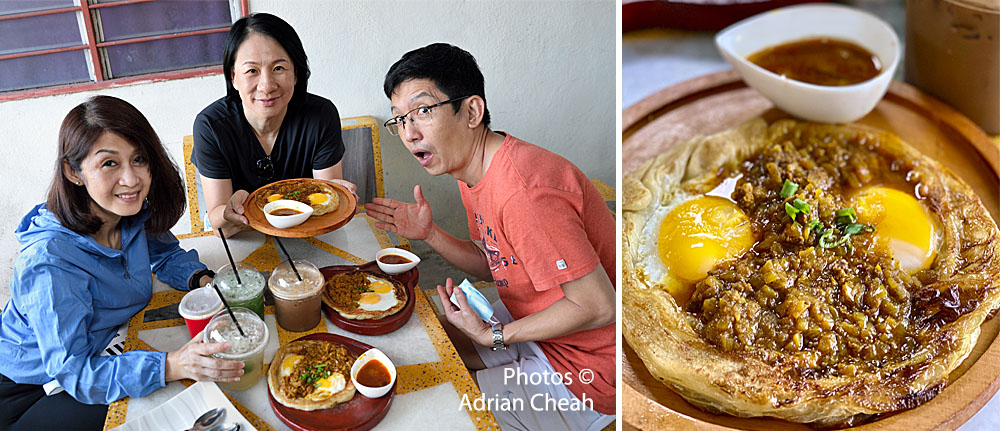Inventive roti canai sarang burung in Balik Pulau

Being a popular dish among Penangites and Malaysians at large, roti canai or roti paratha is a flaky, moreish flatbread enjoyed any time of the day. Made with flour, water, salt, a little sugar and fat, the mixture is kneaded into a dough and allowed to rest. It is then divided and rolled into palm-size balls. The rested dough ball is stretched; held at a corner, it is then flung in the air onto the oiled work surface twice or thrice, stretching it paper thin before folding to obtain a layered texture.
Pan-fried on a griddle with oil till golden, the wonderfully cooked bread is fluffy, layered, flaky and crunchy on the outside and slightly soft and chewy inside. Adding more ghee (traditional Indian clarified butter) or butter to the cooking process will enhance its flavours further.
The best way to enjoy roti canai is straight from the griddle. Certain parts would still be crispy, adding more texture and satisfaction. (When left to cool, roti canai loses its flaky, crispy texture.) The dish is usually served with dalcha, curry or sambal, often a mixture as a side dish.

Nestled in the serene hamlet of Sungai Rusa in Balik Pulau, one discovers Gerai Roti Canai Abah. This hidden gem introduces a distinctive rendition known as "roti canai sarang burung," drawing inspiration from a bird's nest.


The bread dough is stretched and folded into a long strip, then shaped into a ring. It is then pan-grilled till golden. When the dough is thoroughly cooked, two eggs are cracked to fill up the circle. When the sunny-side up eggs are perfectly cooked, they are dusted with some coarse chilli and a little light soy sauce.


In the case of the special choice, a savoury topping of minced meat (either chicken or beef) is spooned in, then sprinkled with some chopped spring onions. The roti is served on a flat wooden dish with curry on the side. The presentation is a visual feast, whetting the appetite.

In July 2020, Muhamad Taufiq bin Rosli unveiled this unique invention and it quickly gained widespread popularity.. With the advent of the internet, Taufiq's instagrammable creation caught on like wildfire and with viral postings from countless food bloggers, the news spread far and wide. This drew in patient patrons who waited in a long queue to relish his roti canai sarang burung.

Taufiq's father initiated the business back in 1988, when Taufiq was just 10 years of age. Eager to help out, he honed his skill learning how to make the best roti canai possible. During our encounter, I found Taufiq to possess a humble yet cheerful disposition. He was happy to answer questions even when he was in his element, tossing the dough in mid-air, stretching it to its thinness. He then applied some butter to the stretch-out dough before folding it into a long strip. (Here, Tufiq was quick to correct my misconception that what he was adding was margarine.)


Since Taufiq's ingenious creation, many vendors have added roti canai sarang burung to their menu as well, reaching as far south as Johor. As Oscar Wilde would put it, “imitation is the sincerest form of flattery that mediocrity can pay to greatness". The next time you stop over at Balik Pulau, do drop by at Gerai Roti Canai Abah for the real treat. I am proud that Penang has many creative minds like Taufiq, transforming the ordinary into something extraordinary.

The breakfast menu at Gerai Roti Canai Abah extends beyond the renowned roti canai sarang burung, featuring a variety of options such as French toasts, tacos (available with fish, chicken, or beef), and a delectable cheesy murtabak. The cheesy murtabak is served akin to a pizza, allowing patrons to customise their toppings according to their preferences.
-------------------------------------
Gerai Roti Canai Abah
Pusat Inkubator Kraf, Jalan Sungai Rusa, Kampung Sungai Rusa, 11000 Balik Pulau, Penang
T: +6018 947 5083 (Taufiq)
Opens daily from 7.00 -11.00 am except Fridays.
-------------------------------------
An insight into the all-time favourite roti canai

In Malay, “roti” refers to all forms of bread although the word could have derived from ancient Sanskrit, carrying the same meaning. (According to the India Times, Sanskrit is the world's oldest language.)
On the other hand, various theories are attributed to the origin of the word "canai". Some suggest that it could have been derived from Chennai (formerly known as Madras) in India or chana, a spicy northern Indian dish (made from chickpeas), with which this type of bread was traditionally served. In Malay, one of the definitions of "canai" is "to roll so that it is flat and thin"; it is another plausible explanation connoting the making process of the flatbread.
The existence of roti canai in Malaysia can be traced back to the large numbers of Indian presence by the turn of the 20th century, especially with the arrivals from the state of Tamil Nadu. By the 1920s, the comforting combination of roti canai and meat-based or lentil curry, a meal in itself was being readily served from Indian Muslim stalls throughout the country. Its humble origin has given birth to many iconic sweet or savoury options available today.


There are countless roti canai stalls in Penang, many offering more than just plain roti canai (round or square shaped) or roti telur (encased with a beaten egg). They would also serve roti telur bawang (with an egg and diced onions), roti bom (a smaller coiled version, sweetened with sugar), roti sardin (filled with sardines), roti tissue (one huge crispy thin cone-shape sheet drizzled with condensed milk) and roti pisang (encased with slices of banana).
Many thanks to Taufiq for adding another variety to this extensive list.
-------------------------------------
Written and photographed by Adrian Cheah
© All rights reserved
17 December 2021